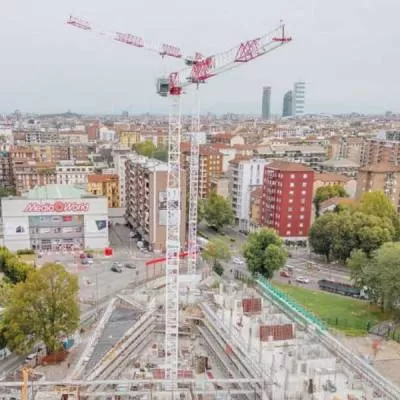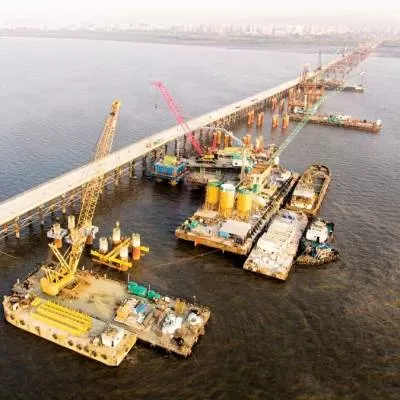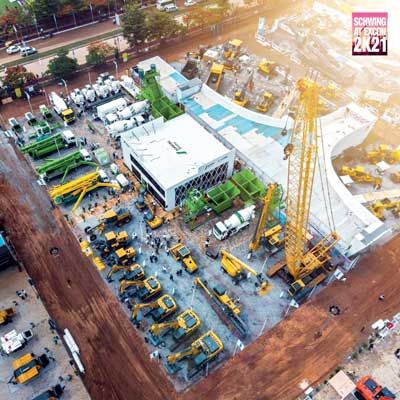Ar-Rising Stars
Read full article
CW Gold Benefits
- Weekly Industry Updates
- Industry Feature Stories
- Premium Newsletter Access
- Building Material Prices (weekly) + trends/analysis
- Best Stories from our sister publications - Indian Cement Review, Equipment India, Infrastructure Today
- Sector focused Research Reports
- Sector Wise Updates (infrastructure, cement, equipment & construction) + trend analysis
- Exclusive text & video interviews
- Digital Delivery
- Financial Data for publically listed companies + Analysis
- Preconceptual Projects in the pipeline PAN India
Amid existing challenges, how ready is India for young, fresh, creative new design architecture? CW PROPERTY TODAY explores further. Urbanisation taking off at an exponential rate has built up momentum in Tier-II and Tier-III cities, especially when it comes to architectural design trends. Inevitably, these cities are now evolving as major markets for young, aspiring architects. People in these emerging cities are getting increasingly open to trying different spatial designs, forms and materials, according to Kunal Mohan Naithani, Design Principle and Founder, White Studio Architects. “Also, there is the financial capacity and spending power in most of these towns to ask for nothing less than the current and best world-class design trends.” This has provided a massive window of opportunity for Indian contemporary architectural design. Listing evident trends, Vivek Gupta, Founding Principal, Arvind Vivek and Associates, says, “With increased emphasis on outdoor living, homes have de-formalised, giving way to spaces without any solid distinction between interior and exterior. Additionally, eco-friendly designs have reached a new level. There has been widespread increase in the use of green walls, green terraces and eco-friendly materials.” Clients are open to progressive design and radical ideas, which Huzefa Rangwala, Director and Co-Founder, MuseLAB, attributes to the Internet and globalisation. “Better infrastructure and understanding of integrating indigenous construction techniques with locally sourced materials are being hailed as the new design mantra for most architects and interior designers.” Meanwhile, Debmalya Guha, Principal Architect and Planner, Pace Consultants, says, “As affordability is rising but awareness and exposure to modern architecture are lacking, the expectations from the architect are often appalling. As enforcement of building rules is less stringent, the architect is often forced to flout them, which not only compromises the overall built environment of the city but has a large ecological cost.” However, despite these challenges, Guha sees great prospects considering the quantum of work, and emphasises upon much-needed support from both government agencies and the Council of Architecture (CoA). Potential amid challenges At present, India is experiencing a new surge of architects and many of them have been successful in establishing themselves as eminent designers of this era. However, Gupta is a firm believer in ‘built-to-suit’ architecture, which comes with a strong acknowledgement of climate, coordinates and client. According to him, every new-age designer and architect should be able to imbibe this concept, which will aid them to perceive the psychology of the project and cater to it accordingly. With the view that challenges are huge but different compared to generations currently established and gone by, Naithani says, “The new-age client is much more in touch with prevailing local and worldwide design trends, thanks to the Internet. The challenge to ‘impress’ is the highest it has ever been. The client is far more aspirational nowadays, both in terms of the functionality and aesthetics of the built space.” Having said that, the grooming required to prepare them for these challenges has unfortunately still not caught up in architectural schools. “It is like the world has moved onto Allen keys and we are still handing them screwdrivers!” says Naithani, adding that the CoA and All India Council for Technical Education (AICTE) really need to pull up their socks. Rangwala adds that CoA needs to regularise the contractual legalities and liabilities between the architect and client. There needs to be a standardised system in place for approvals from liaising agencies. “Education in architecture and interior design school only talks about design but there is no focus on the business of design, which I feel becomes a huge setback for rising architects who not only suffer setbacks in initial interactions with clients but face tremendous challenges when it comes to running an office,” he elaborates. Also, while the identification of urban development as the driver for economic and social growth by the government opens up unprecedented opportunities for rising architects, there are critical challenges to be addressed. Guha lists two major ones: The archaic tendering process, which government agencies adapt, curtails the hope of young talented architects. They cannot participate in the tendering process owing to financial criteria (such as annual turnover above crore) that only large companies can meet. This may be an effective selection parameter for contractors, but not for architects. Architects should be selected by design competitions, not tenders. The architectural profession is becoming financially unviable as prices are being under-quoted rampantly by compromising quality in the tendering process. The government selection process is engaging the L1 (lowest bidder), disregarding the qualitative and creative aspect. Moreover, this system encourages corruption as dishonest agencies often bid unviable low rates to get the project, then profit in illicit ways. Any building is a national asset and any agency compromising on quality to save a meagre 1-2 per cent of the project cost (maximum architect fee is only 5 per cent) should be considered criminal. Young, fresh, creative? India being a resource-crunch country of 1.2 billion people where a large portion lacks human habitable homes after more than 70 years of independence, an ideal way forward would be to implement young, fresh and creative design ideas. “It is time to realise that old, archaic, prosaic architectural ideas have failed us and will continue to fail,” says Guha. “Although it is a herculean task to convince a builder or government agency to adapt energy-conserving, resource-efficient, creative design ideas, it is reassuring to see so many sustainable buildings coming up across the country.” Architecture should not be stagnant and fresh ideas should flow into the continuum, believes Gupta. “Material innovation, climatic responsiveness and a design approach discrete from each project to enrich spatial experience are what every budding architect should aspire for.” For his part, Rangwala feels the Indian design fraternity and maybe a certain percentage of the lay population is ready for young minds. However, he points out that every young architect or designer stands a chance of being ‘used’ without being remunerated for their services. Unless backed by a strong reference, established developers rarely opt for newcomers. “There are times, though, that young architects are responsible for strong concepts and eventually collaborate with older, more experienced architects to rationalise the technical details of the project.” As Naithani sees it, the fraternity has few and far between who are honest to themselves and their craft, let alone the client! “An insignificantly miniscule percentage of the luxury individual home owner or the visionary business owner in India is ready to accept the same on paper, at the initial design stage for sure, but not mentally prepared for what it entails in terms of time and money, in that order,” he shares with candour. “On the other side, the average developer is not ready to accept anything that compromises on functionality and space-leasing efficiency, let alone build cost – and you cannot really blame them, given the volatile real-estate market. Last, the industry itself is not equipped to handle the execution finesse required with these radical design concepts. This is where the reference of nonsensical mimicry comes in. When architects attempt to create a Zaha Hadid styled building, with its skin peeling and crumbling in 12 months just because Rs 500 was spent to mimic something that should have been Rs 50,000, it further takes developers and owners into their shell rather than experiment with bold buildings.” Global designs with local flavours Architects often take inspiration from global designs to offer India a fresh and creative skyline. But how much, and how is this being localised or recreated for the Indian scenario? Naithani seeks a lot of inspiration from global designs, especially Southeast Asian countries – the way they draw out design ideas from the West and beautifully infuse local, tropical flavours in them. “There is no shame in getting inspired from works abroad,” he says, seeing inspiration as a splash of fresh water any seedling needs to sprout and thrive. “A trend is prevalent of localising international design trends, especially with innovation in infusing a lot of local materials and applying them on European design forms,” he says. “A lot of it is interesting and there are quite a few firms doing brilliant work in this domain.” Having studied at MIT and with immense international experience working in the US, Slovakia, Saudi Arabia, Japan, and Australia, Guha came back to his roots where design solutions are crafted independently for each project considering the needs and aspirations of the client, the contextual influences and latest global design ideas. “We take particular care to make buildings energy-efficient and socially relevant,” he says. “We specialise in concept-based designs, taking care to make them sustainable ecologically and economically and unique in nature, transcending the expectations and dreams of everyone associated with the building into a memorable experience.” All considered, design is contextual and addresses the needs of a certain community, region, country, culture, and so on. “One cannot localise a global design as it might not apply to our country, for instance, in terms of the climate,” observes Rangwala. “However, one can apply the approach to design. That’s where one needs to derive inspiration.” Young architects who study aboard apply digital marketing techniques and parametric aspects to design built with local craftsmen using local materials. Without a doubt, India is slowly drawing close to the developed world in the architectural context. “The influx of new technologies and design ideologies is aiding the elevation of Indian architecture,” concludes Gupta. He believes that ‘recreation of styles’ will now be reversed and, internationally, “our architectural perspectives will flourish further.” Dreams for India Debmalya Guha, Principal Architect and Planner, Pace Consultants, dreams of building a city that is SAFE (sustainable architecture friendly to ecosystem), where a child can live to become a better human being. It would require wisdom and not just smartness, “which is quite unappreciated and more unavailable these days”. The dream project of Kunal Mohan Naithani, Design Principle and Founder, White Studio Architects, is a significant government building. “We really have not built anything to be proud of since the British left us the buildings they did. In fact, it has been so long that these buildings are now under the ‘heritage’ category!” He believes a change will come about when someone really looks beyond the bureaucracy and awards such government projects to fresher, more open minds – not necessarily young firms, as there are plenty of established architectural firms with great design philosophies – “instead of constantly awarding them to firms who are either good at manipulating the system or massive shark firms who are not really interested or feel passionately about such projects.” While the Indian megapolis is on the verge of imploding under the pressure of its own inefficiencies in meeting with the growing population and the demands tantamount to that growth, the dream of Huzefa Rangwala, Director and Co-Founder, MuseLAB, is one of urban regeneration: To create urban rooftop gardens above every available terrace of buildings, public parts and communities or farmers’ markets under flyovers; essentially, to make the city more liveable. “Of course, this is a vision a lot of us young architects singularly dream of, but only a collective effort can actually help us realise this.” Vivek Gupta, Founding Principal, Arvind Vivek and Associates, believes in realising his dream of designing through each of his projects. “Think of my projects like savouring a dish; you give me an egg and instead of an omelette I will present a soufflé!” To explore and test responses, to produce designs that fulfil the spirit of the brief in an inventive and unique way are what keep him going. - SHRIYAL SETHUMADHAVAN




















